This page was made in close cooperation with desertpistons.com
|

Desert pistons.com |
Rally participation in the 80s
Paris - Dakar,
5x5 Transafrica 80
Rally of the Pharo's
|

 |
More info on the early editions of Paris-Dakar 1979 - 1985 |
|
Above an original 500cc Valentini Camel from app. 1985.
On this type of bike Massimiliano Valentini participated in desert rally's
like Paris-Dakar |
Introduction
The information on this page was quite difficult to find. Especially North of the Alps, were information on Kanguro's and Camels
from Valentini is very scarce. On this page, I've tried to make some scene of the scattered information of these rare machines.
It is remarkable to realise that Moto Morini has been on the basis of desert rally's! At the time, the Morini Camel 500 and also the
BMW GS80 were the first 2-cylinder offroad bikes. The Morini had real offroad capabilities. The BMW became a very successful bike as
a "travel enduro". The Morini Camel 500 was sold in very limited numbers, probably caused by poor marketing and also because of the
limited capacity of the factory. Pendant of the BMW and Camel was of course the Yamaha XT500/600. The XT500 single ("thumper") became
a real classic bike.
Moto Morini had built enduro/off road motorbikes in the 60s and 70s, based on the Corsaro 125. Antonio Valentini (a successful dealer
from Prato/Italy) would ask the factory to build a 500cc enduro/off road. Valentini built the first three prototypes with support of the
factory. Because Massimiliano (Antonio's son) immediately took the machine to the North African desert (Sahara), the new motorbike
was named "Camel".
|
Valentini, the company
In the 50s, Antonio Valentini was very successful at racing motorcycles. He also had excellent technical skills. After his racing
career and with his experience, he started his own motorcycle company. His company became a Moto Morini dealership. Apart from the
standard motorbikes, Valentini soon produced all kinds of plastic parts for the 350cc and 500cc. Also, Valentini supplied tuning parts
like cylinders, pistons and special mufflers (exhausts). In the mid-80s, Valentini presented it's own designed and build prototype of a
350cc (watercooled)"Kanguro H2O". Bikes with Valentini plastic plastic panels and parts do not automatically have a tuned
engine, as these fairings, fueltanks, etc. were individually available. So with a Valantini bike, it is never certain if it is a tuned
motorbike, or a standard motorbike with just the plastic parts.
For a longer period of time, this was an important task for the Valentini dealership. Antonio Valentini mentioned the following about
this work in a 2005 interview: "For years we transfered standard bikes. We had complete kits available and we listened to the customers
wishes, but took into account his financial possibilities. The complete set of parts included a fueltank for those who only wanted to do
some enduro riding. They did not need the large square fueltank, further the set included a double headlight, double exhaust, sprockets
and chain. Furthermore we tested the bikes. Customers came from all over Italy. We had two or three mechanics who were just involved in this
type of work. The customer would call us, make an appointment and we took the whole day to update his bike. The customer went home and
afterwards we sent him the replaced parts by post". |
 Antonio Valentini |
|
Below: the Valentini 350 Special:
* lhs, "350 Valentini Special", typical 70s design,
* rhs an advertisement for the "Special kit", consisting of:
2-into-1 exhaust, rearset, 3 Bremo discs and the polyester
parts like fairing, seat, fueltank and mudguards (fenders). |
Hieronder: de Kanguro X1
in Valentini uitvoering. |
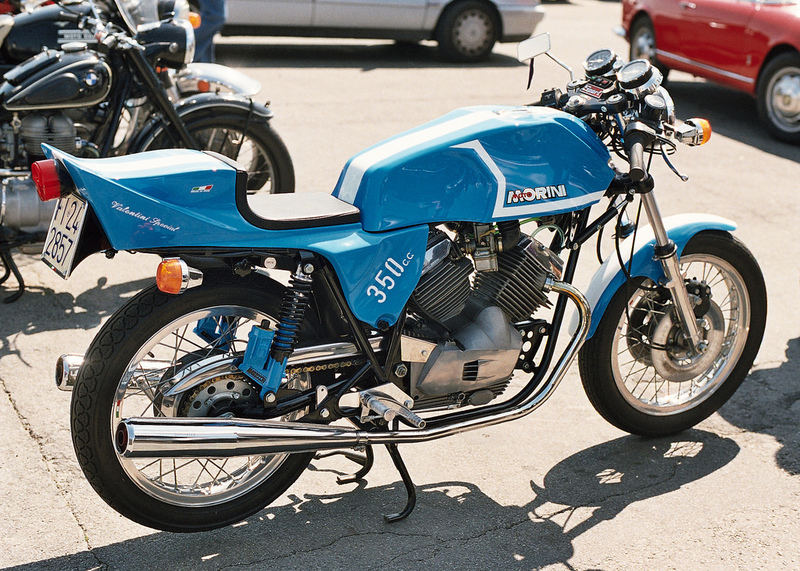 |
 |
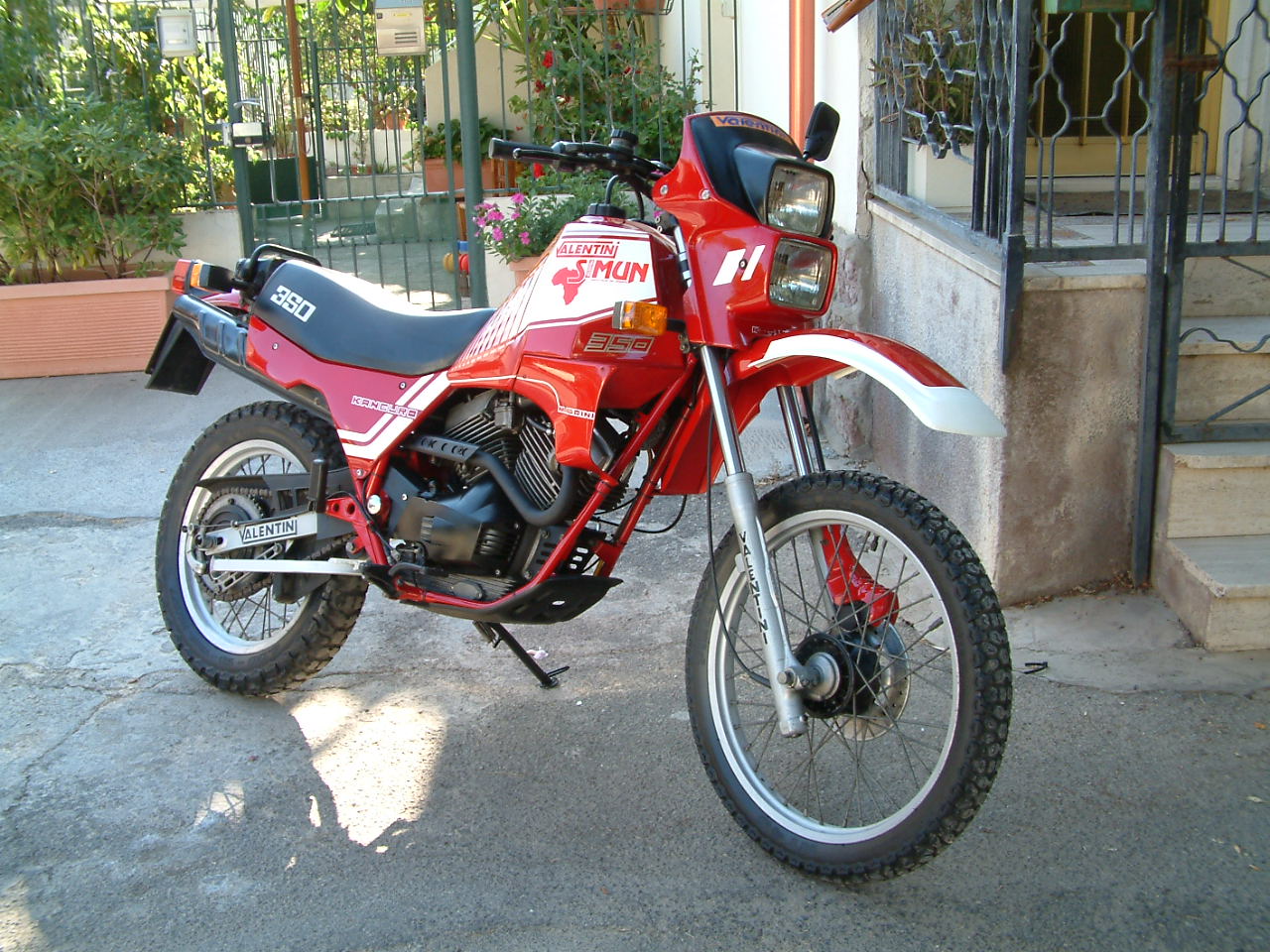 |
| |
|
First Camel
In the Autumn of 1979 Valentini built the first three prototypes of the 500cc Morini off-the-road (6-speed), based on the
streetmodel the 500 SeiV. The company was supported by ing. Lambertini,
technical director of Moto Morini and designer of the Morini v-twin models. Lambertini laer mentioned: " Valentini, our important
dealer in Prato came storming in. He was determined to get an offroad bike from us. Then we decided to bring the Camel to live. Basis
was the 478cc SeiV streetmodel. The frame of this bike was good and with minor adjustments it was suitable for it's new purpose. With
springs/shocks for offroad use, the end result was well-balanced. For the engine, we used a different, more flat camshaft to generate
more torque at lower revs.".
|
Massimiliano's ambition
Massimiliano Valentini (?09/1998), partly followed his father's footsteps, because from the early '80s
he took part in enduro competition and also desert rally's. With the three 500cc prototypes Valentini registered for the
"5x5 Transafrica 80" rally.
1980
The 5x5 Transafrica 80 rally started at the 29th December 1979 and lasted until the end of January 1980. Total distance app.
7,000km's (4,375 miles). Start was in Abidjan, Ivory Coast. From there the route took the riders North through countries like Burkina
Faso, Niger and Lybia. Finish was in Turin. The team valentini consists of three riders: Massimiliano Valentini, Leandro Ceccherelli and
Giuseppe de Tommaso. At the end of this extremely tough rally, only 6 (out of 26 started) make it to the finish. Among them: Ceccherelli
ended 4th and Valentini ended 6th. De Tommaso made a very bad fall and had to give up. A year later this young rider and journalist
would die in a car accident during the Paris-Dakar rally.
During the rally in Afrika, the bikes were very fast, according to Antonio Valentini. Lack of experience of the riders is the cause
that they stay a little behind in the overall ranking. The trial tyres which all Italian participants use are inadequate for the rough terrain.
Yet, these were recommended by Pirelli. The (rear)sprockets of aluminium wore quickly in the African sand and the standard chain adjusters
were insufficient to keep the right tension in the chain. The factory informed Italy of the success in the African desert and soon everybody
in Itaky was talking about "the great Italian enduro".
From Valentini Camel to factory Camel
De factory supported Massimiliano and his team members' participation to the "5x5 Transafrica 80 rally" Moto Morini advertised
with the participation of their 500cc offroad during this rally. The factory proudly announced that of "three prototypes with 500cc engine
(meant is the Camel-ed.) two made it to the finish in Tunis "Total distance of the rally was app. |

|
Next, in the Autumn of 1980, the Camel was taken into production by the
factory. In 1981 it became more widely available for customers. These Camels had a red tubular frame. The first 50 built had a white
polyester fueltank and white sidepanels. Total production of this first model was limited to app. 200~250 bikes. The second build series of
Camels (of this first model) was mostly red of colour. Also the badges on the fueltank and sidepanels were different, but these bikes were
technically identical to the first series.
The Valentini Camels were clearly different in certain details, compared to the Camels later build by the factory. The rear swingarm
was different/reinforced, the shocks are of a different type and are mounted in a more upright position. Also the shape of the fueltank
is slightly different. I have reason to believe the small model fueltank, used during the ISDT/Elba is made of steel; the larger fueltanks
used during the desert rally's are made of polyester. Also the Camel made by the factory had a polyester fueltank.
Below some photo's of the Valentini Camel in six-day-enduro trim.
|
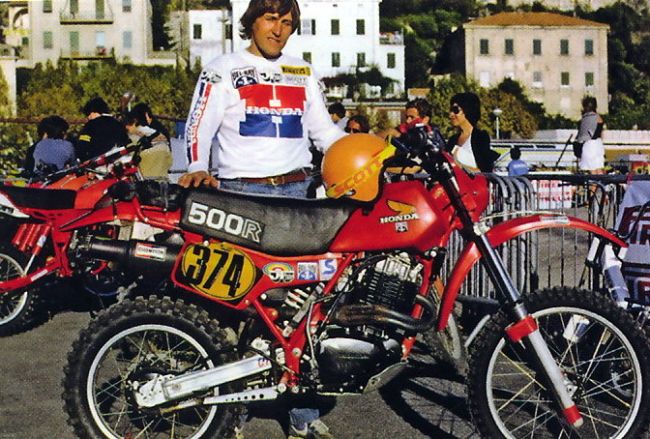 |
7,000km's and took the riders through countries like Ivory Coast, Niger and also the desert of Libia. One of these three bikes has dropped
out of the race by mechanical problems. This confirms the outstanding quality and performance of Moto Morini", according to the text of the advertisement. |
 |
Dutch and international motocross champion Gerrit Wolsink, with his Honda 500R.
He beat the Italians on the Morini Camels in the 500cc rankings.
(Among many other titles, between '75-'79, he won the Carlsbad motocross GP in the US 5 (!!) times).
His photo was taken at the same location as the photo of Massimiliano Valentini. |
|

|

|

|
 |
First 50 build Camels were white |
Second series of the first model in red |
The end classification of the ISDT 1981 (six-day enduro)
on the island of Elba. Italy won
both the Trophy as well as the Cup. Netherlands achieved a
6th and 4th position!
|
Above and below: Valentini Camel in six-day enduro trim |
|
 |
|

|
 |
Rhs: logoof the 1981 ISDT which was held on the isle of Elba.
It reads: "Campionati del Mondo Regolaritá.
Isola d'Elba 5-10 October 1981". |
|
|
For a fast opening/closing of the valve covers |
|
 |
 |
 |
 |
Massimiliano after arrival at the island of Elba for the ISDT (1981).
Below, the same place in 2011
|
Valentini (362) achieved
a 3rd place in the final classification |
Team member Marco Elmi (367), achieved a 7th place |
Team member Nardo Noé (365) had to give up |
 |
Please note: While compiling this page, I found more models
of different Valentini fueltanks. They are meant for the offroad
Camel and Kanguro. Some of them perhaps not the best samples
of Italian design, but very practical for long distance riding. Fortunately
it's easy to swap fueltanks on the offroad models ;))
|
|
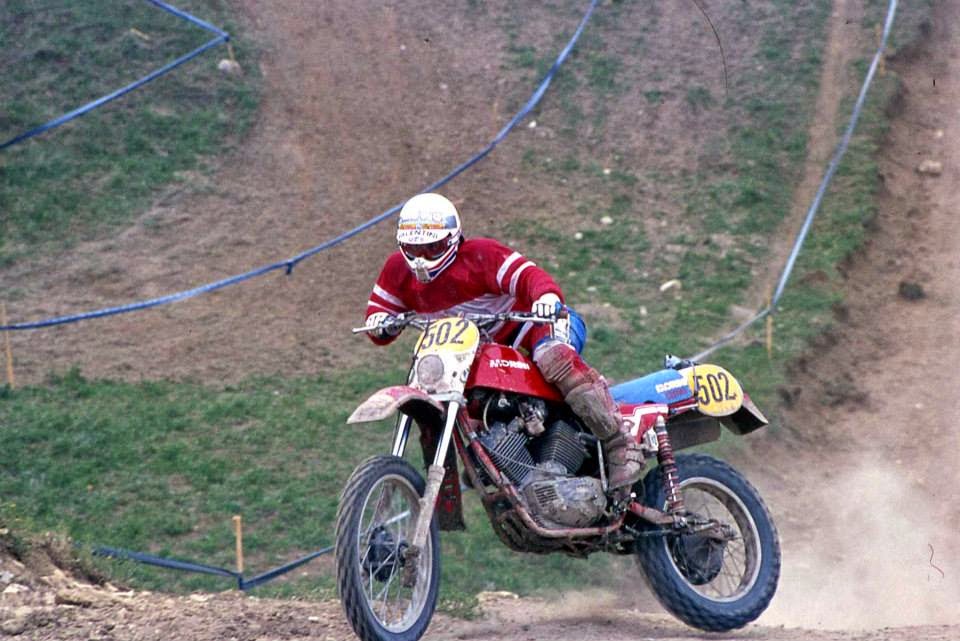 |
|
Rhs a page from a Spanish motorcycle magazine on the development of the Camel.
The Valentini Camel at the top of the page is one of the three proto types used during the 5x5 Transafrica 80 rally.
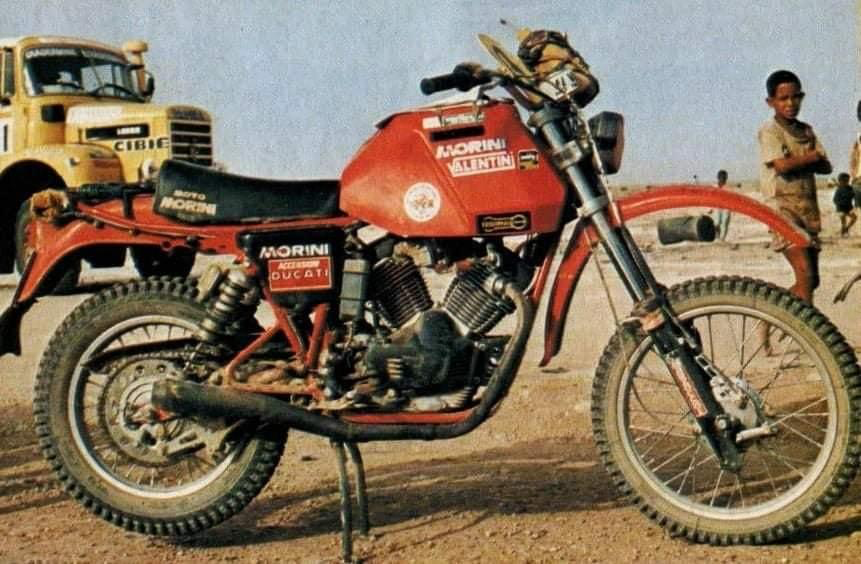 |
 |
 |
 |
 |
28, 29 and 30: Valentini Camels |
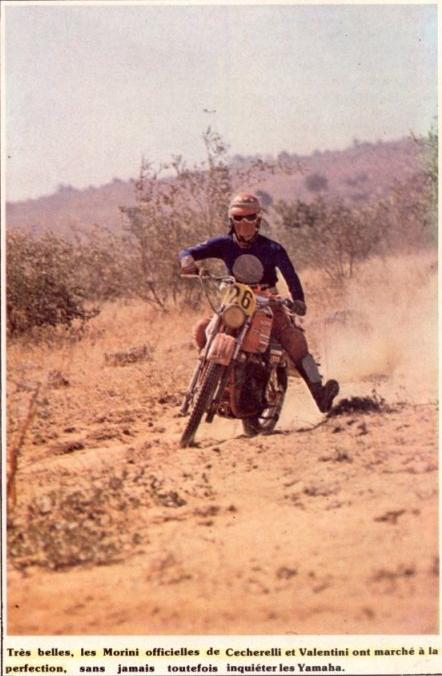 |
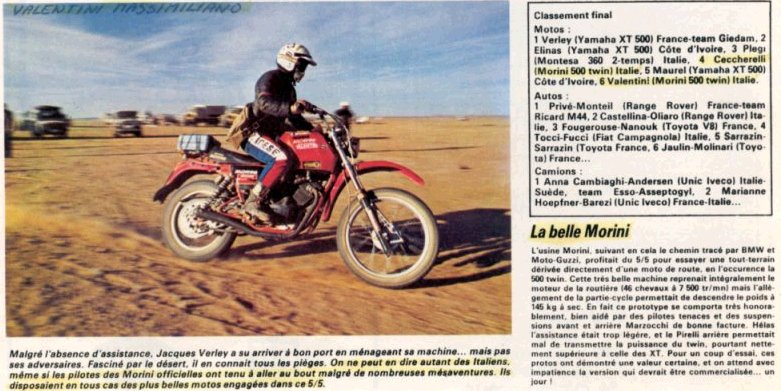 |
Lhs: Massimilano Valentini during the
5x5 Transafrica 80 rally. Next to the picture you can read the final classification: Ceccarelli 4th, Valentini 6th
 |
 |
Above: factory advertisement. Most likely,
the rider on the picture is Leandro Ceccarelli:
A) because he became 4th and
B) Gianni Gagliotti did not make it to the finish.
Lhs: Valentini in 1983.
Below: photo album, nice souvenir of the 5x5 Transafrica 80. |
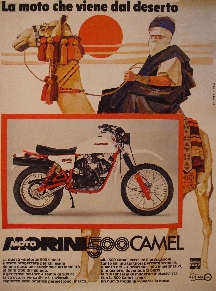
Advertisement "La moto che viene dal deserto" or the bike that comes from the desert. |
1981
Team Valentini is supported by the factory and participates to the competition of the Italian enduro championship in the
senior class above 500cc 4 stroke. Both competitions in Camerino were won by Valentini and his team member Elmi.
Marco Elmi achives a second place in both competitions in Rocca di Ruffeno. In the enduro final classification Elmi becomes 2nd and
Valentini 4th. Valentini participates in the international 6-day enduro on the isle of Elba and wins the golden medal and third place
in the class above 500cc. |
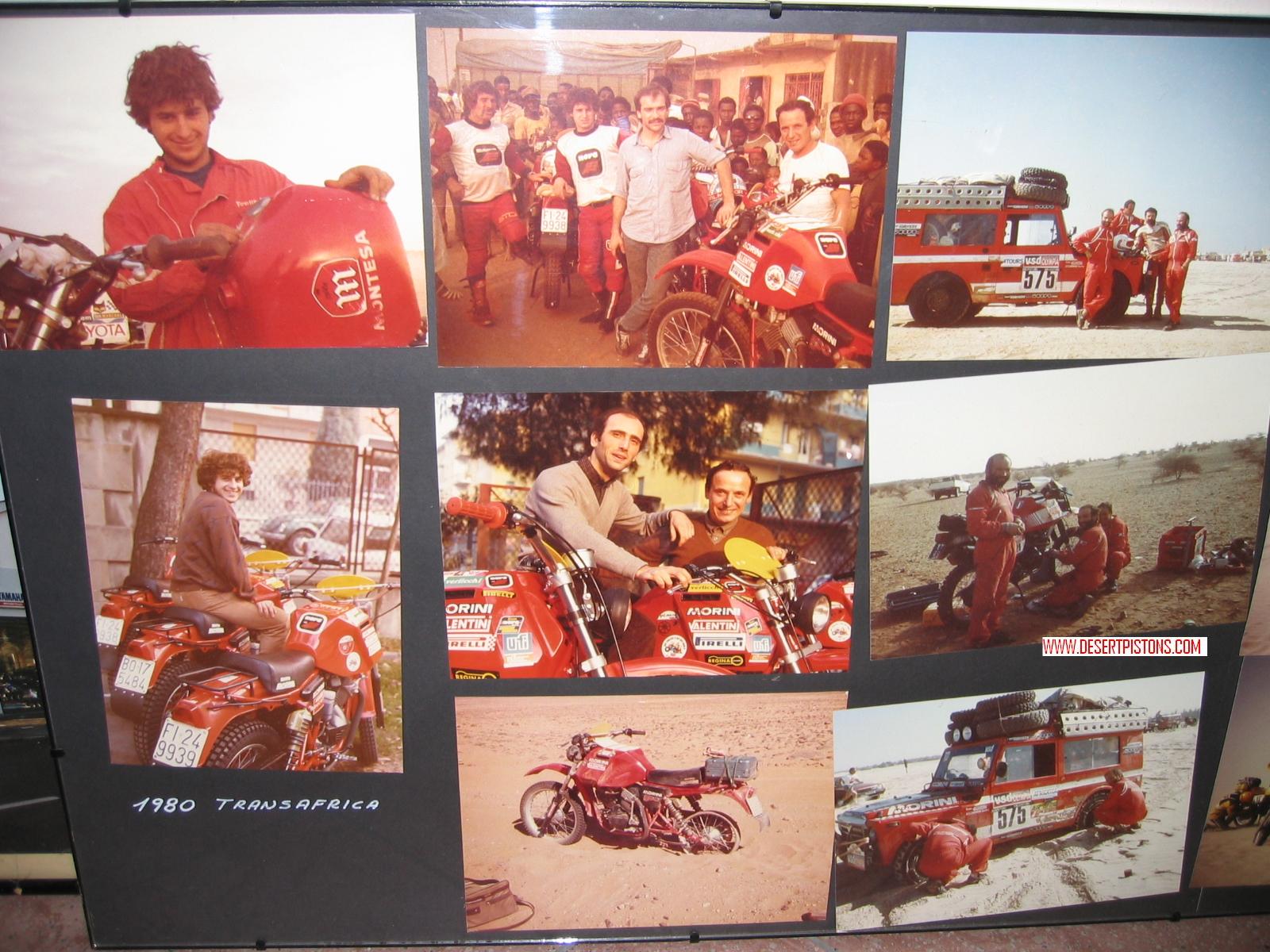 |
Below: Valentini Camel and Fiat Campagnola service jeep in the colours
of sponsor Zanussi. |
|
1982
Team Valentini participates in the classification of the Italian enduro championship
and again, the factory supports the team. Massimiliano Valentini achieves a 2nd place on Elba, twice a 3rd place in San Remo
and 4th in Polte dell?Oglio, 2nd and 4th in Rufina. With these results he became 2nd in the final classification of 1982. |

|

|

|
|
1983
In 1983 the three friends Massimiliano Valentini, Leandro Ceccarelli and Gianni Gagliotti appeared at the start of both the Rally of the
Pharao's, as Paris-Dakar! The rally of the Pharao's starts and ends in Cairo. Total distance app. 3,100km's (1,950 miles). In the final
classification of this rally, Gianni Gagliotti achieves a 9th position and 3rd in his class; Massimiliano Valentini achieves a 12th position
and 4th in his class.
During Paris-Dakar of '83, the three participating Morini?s of Team Valentini are riding on positions 1, 2 and 3. Unfortunately our three
musketeers finally have to give up, after the cambelt of the camshaft badly frayed by the impact of the desert sand.
|

|
| In 1983 Team Valentini had 2 service vehicles to their disposal. Among the drivers Antonio
Valentini and accompanied by the mechanics Ivano Masseluci and Aligi Deganello. Both service jeeps of course Italian made Fiat Campagnola's. |
 |
Also the sponsor was Italian: Zanussi, a well-known brand for electronic products like washing machines and TV's.
The whole Team wore the bright yellow outfits, the colour of the sponsor. 
|
(84) Massimiliano Valentini's bike | |
Above: Marco Folignati nr 14.
Back in 1983, he was the 4th participant of Paris-Dakar on a Valentini Camel. Like the three other riders, he did not make it to the finish.
During two other Paris-Dakar rally's he rode a Yamaha XT500. Unfortunately on this machine he did not make it to the finish either.
Because of his deviating number 14 it is not likely that he was a member of the Valentini Team. He does not wear the typical yellow outfit.
On the picture, you can clearly seen the air intake for the airfilter (the black stripe on the side
of the fueltank). |
|



![]()